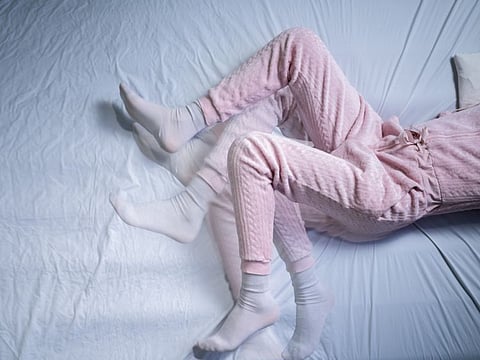Why Restless Leg Syndrome is giving us sleepless nights
Condition has no known cure but can be managed well in holistic way, UAE doctors explain

Dubai: Do you ever have an urge to kick or move your legs constantly when you retire for sleep in the night? It is likely that you might have Restless Leg Syndrome (RLS).
Take the case of a 30-year old young man who was unable to sleep at night, because he had this urge to move his legs constantly. This not only left him sleep deprived and tired, but also short-tempered and impatient at work, so much so that he was fearful of job loss.
A few weeks after consulting Dr Bobby Jose, specialist neurologist and medical director at NMC Hospital in Sharjah, he was put on mild medication that is used to treat diabetics who suffer neuropathy and advised yoga as well as leg massages. The combination of holistic approaches has relieved the young man who reported tremendous improvement in his sleep and a diminished urge for restless shuffling of his lower extremities.
Get the correct diagnosis

Why does RLS happen?
He added: “RLS happens due to a disruption in the neural pathways of the basal ganglia of the brain that supply the hormone dopamine. The reason this happens is partly attributed genetics, like a family history of RLS in first to third degree relatives, and it could be triggered by stress and anxiety too. So far, doctors have not been able to isolate the gene behind this.
Usual symptoms
Patients who suffer from it complain of a dull pain in the lower limbs. Usually dopamine production falls by the end of the day and with this disruption occurs mostly at bedtime for patients. “Patients say they experience a crawling feeling on the legs, a dull pain that gets better only when it is shuffled or shaken. Their urge to kick in the air or move their legs constantly comes from the need to mitigate the pain and unnatural sensation. As a result of this, their sleep quality and duration suffers making them very irritable, sleepless and tired in the day.
Who is at risk?
Although such neurological deficits happen with advance age, RLS triggered by anxiety and stress can happen in younger people too. “In children we have often seen such behaviour that happens due to a severe iron deficiency. In pregnant women, the condition can be manifested in the last trimester due to lack of proper circulation and stress. However, in kids, once the iron is replenished, and in women, post pregnancy, the symptoms disappear.
How to manage the condition
“Actual RLS cannot be cured, it can be managed and with a combination of specific medication to address the disruption of the dopamine pathway. In addition to this a holistic approach to help that can be introduced with good diet, proper sleep, yoga and breathing exercises to relieve stress, can help mitigate the symptoms well. One of younger patients who suffered from it, has reported marked relief after he joined regular yoga classes and now I am in the process of tapering off his medication,” said Dr Jose.
Avoid confusion with other illnesses
In patients with kidney failure who go for dialysis, there are symptoms similar to RLS. They experience, a pain, a burning sensation in their lower limbs, however that is due to poor circulation in the lower limbs due to renal failure. In case of diabetics, who experience numbness in their lower limbs due to a lack of circulation and loss of sensation in their feet, similar situation occurs. However, this is a patient with diabetic neuropathy who requires better blood sugar control and diabetic management. These patients will not benefit with RLS management.
Similarly, people fear that RLS might mark the beginning of PD. This is not true either, said Dr Jose. Although both PD and RLS are connected to dopamine production, RLS is only caused by a disruption in dopamine pathways. Therefore, RLS and PD are illnesses that are different in their etymology and impact.
What can help?
Physiotherapy and massage can improve circulation and provide an important step in management of RLS, said Dr Azam Badr Khan, specialist in Orthopaedics and Knee replacement at Prime Hospital.

“The US FDA has approved a new wrap around, low vibration massager that can be used closer to bed time, to improve the symptoms and provided added relief for the patient to be able to sleep. In any case, once the patient is able to sleep well, the symptoms do mitigate on their own.”
Role of diet in improving RLS
• Include potassium rich foods such kiwi, banana and chia seeds in your diet. That can help in better sleep and reduce the restlessness
• Include whole foods, fresh fruits, seeds, nuts and leafy green vegetables in your diet.
• Since iron deficiency can trigger RLS-like symptoms, including iron rich natural foods can result in dramatic improvement in RLS.
• Research shows that a deficiency in Vitamin D could also cause RLS like symptoms. So make sure to get plenty of early morning sunlight and take Vitamin D supplements if you are deficient.
• Avoid, fried, high sugar foods that can aggravate RLS
• Cut back on alcohol, nicotine and caffeine, especially during bed time
• Avoid a sedentary lifestyle and introduce regular walking and exercise for a minimum of 30 minutes, daily
• Yoga and deep-breathing can help reduce stress and since stress has a direct impact on aggravating the symptoms of RLS, it is advisable to introduce these lifestyle tweaks in your daily routine
Sign up for the Daily Briefing
Get the latest news and updates straight to your inbox



